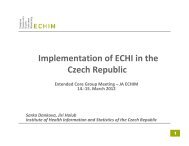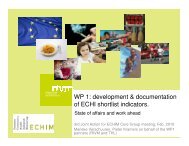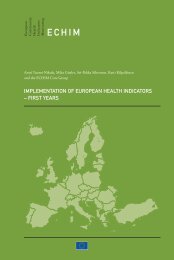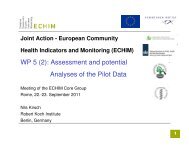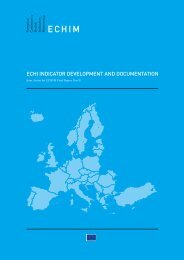INDICATORS
ECHIM Final Report
ECHIM Final Report
Create successful ePaper yourself
Turn your PDF publications into a flip-book with our unique Google optimized e-Paper software.
7.1. Current state in Europe<br />
Health information systems and, by the same token, the availability of data and<br />
indicators differ widely between EU countries.<br />
These differences reflect different historical developments and also some differences in<br />
current perceived needs for information.<br />
In several countries health information systems are quite advanced and it will be relatively<br />
easy to implement the health indicator system. In a number of other countries, more<br />
work will be needed.<br />
Another determining factor is the extent of regionalisation in national administrations<br />
and health care systems. In strongly regional structures, health information varies from<br />
one region to the next.<br />
The influence of history is reflected in many systems having access to and providing to<br />
international databases mainly data on demography, mortality and causes of deaths.<br />
Because of the long history of infectious disease surveillance and control and the<br />
existence of a European institution (ECDC), information on communicable diseases<br />
and vaccinations is also widely available.<br />
However, although all the current data and indicators may continue to be necessary<br />
in the future, the real needs of current public health policy call for a much broader<br />
complementary information basis.<br />
7.2. Availability and comparability<br />
Many efforts in the area of health reporting have shown that truly comparable data<br />
and indicators between EU countries are rare. This remains the case even though most<br />
EU countries carry out Health Interview Surveys. Some comparisons can be made on<br />
such aspects as smoking habits, obesity, self-reported diseases and use of medicines, or<br />
on some diagnoses drawn from health care utilisation data, but only in analyses limited<br />
to a few selected countries. However, comparisons cannot be done between all the EU<br />
countries or between a wider range of health-related issues. In the future, EHIS may<br />
help to improve the situation.<br />
Health policy actions need to be grounded in information on, for instance, risk and<br />
protective factors of major public health problems, on functioning and on care needs<br />
in different countries and over time. Examples of risk factors include hypertension and<br />
76




